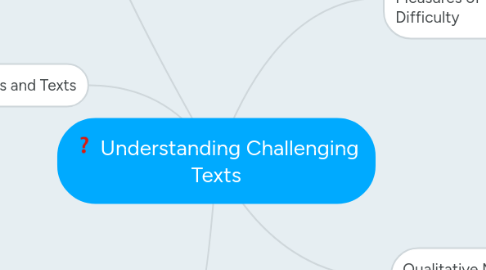Understanding Challenging Texts
by Justin Downer

1. Seminal Works in the Disciplines
1.1. Many students learn habits in high school that are based on required reading, and not wanting to learn content on their own.
1.2. Misconceptions are that preparing a student to be able to read college texts independently will enhance their capabilities in college.
1.3. Students spent 3.6 minutes a day reading informational text
1.4. States continue to drop standards, rather than changing curriculum or text options. They are changing the requirements rather than finding a way to adjust to a student's ability to achieve the standards.
2. Readers and Texts
2.1. Text difficulty must include the measure of a reader's skill set.
2.2. Text cannot be determined how difficult it is on an overall basis, but rather on an individual basis.
2.3. Lexile predicts at what level or which book is considered challenging for a student independently.
2.4. Socially or thematically some text that is considered quantitatively a certain grade-level, may be inappropriate for an individual.
3. A Possible Process for Choosing and Using Texts
3.1. 1. Read for Content- "What can students learn from this text?" 2. Read for Structure- "How has the author structured the presentation?" 3. Read for Knowledge- "What does the author think my students already know"
3.2. Don't over complicate or try to be personal by scratching textbooks, especially for History and Science. They can be analyzed much more than a traditional book.
3.3. Do not ignore quantitative measures of text difficulty, while being aware of the qualitative analysis of text difficulty as foundational planning.
4. Quantitative Measures of Text Difficulty
4.1. Vertical Articulation: A student must be challenged to achieve grade level goals.
4.2. Old standards measured a student's success based on grade level, but the standards never differentiated the difference between grade levels.
4.3. Steps have been taken to make sure students have basic Reading fundamentals rather than pushing the students to be "too challenged"
4.4. Text becomes simple when students are able to indentify individual words in the text that create meaning to overall text.
5. Qualitative Measures of Text Difficulty
5.1. Computer generated tests cannot truly measure the true difficulty of text, especially for each student.
5.2. Quantitative measures may be sufficient but they are in no way enough to understand what makes text challenging or help plan for instructional use.
5.3. As we improve our skills in defining what makes a particular text difficult, we will know better how to make it more accessible.
5.4. Individual teachers are likely to vary widely in the extent to which they are skilled in this type of text analysis, however, there is no substitute to committing to it if you are to plan instruction inline with standards.


